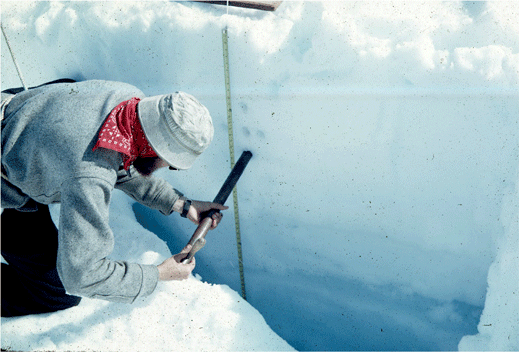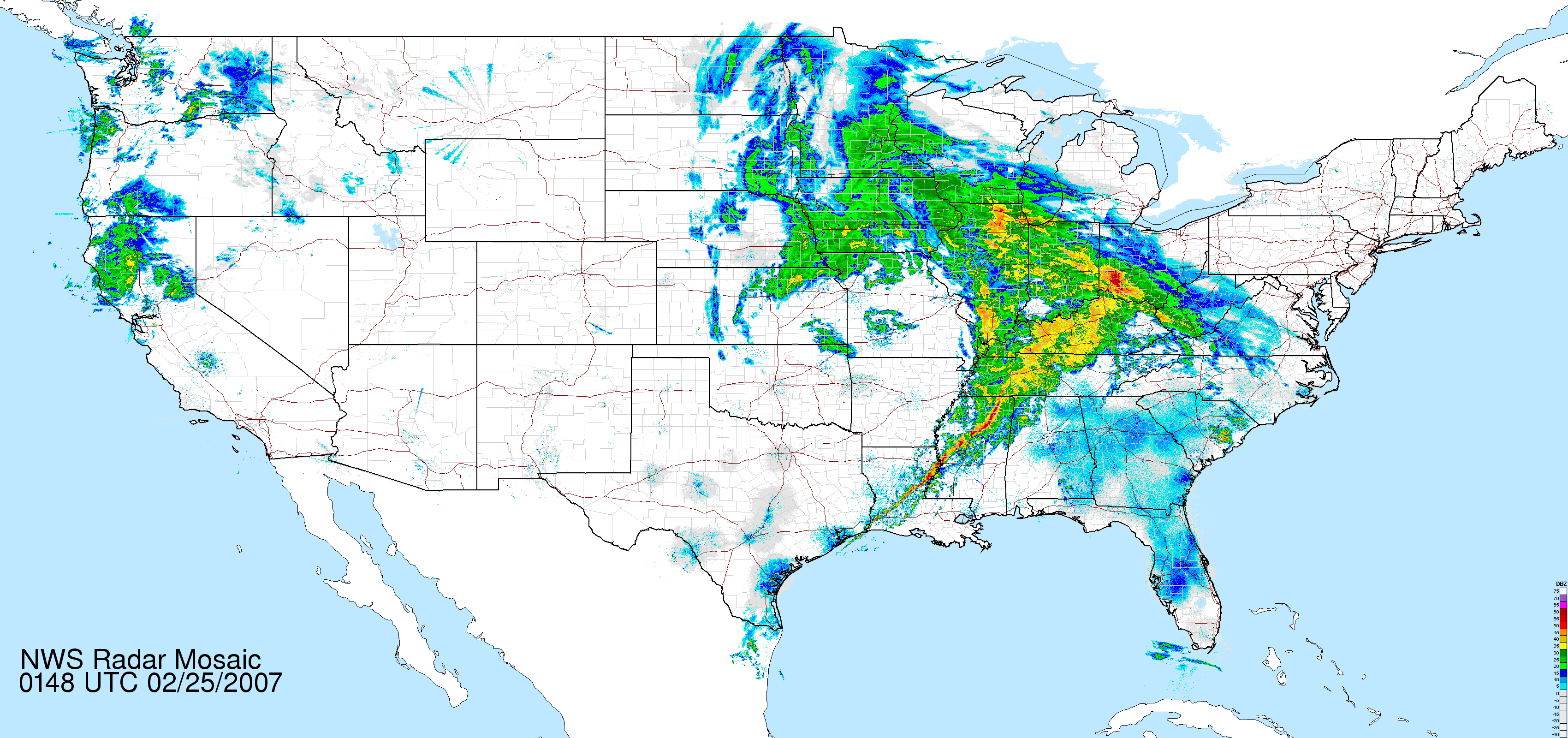|
Snow Pillow
A snow pillow is a device for measuring snowpack, especially for automated reporting stations such as SNOTEL. The snow pillow measures the water equivalent of the snow pack based on hydrostatic pressure created by overlying snow. Any discrepancy due to bridging is minimized by the large dimension of the pillow, typically . Another application for snow pillows is to estimate the snow weight on a roof to warn of potential for roof collapse. Snow pillows were developed in the early 1960s. Set-up Large dimensions (e.g. 3 m × 3 m) of the pillow prevent any bridging that might occur from having an effect on the measurement readings. For snow pressure measurement on roofs using a smaller snow pillow (e.g. 1 m × 1 m) is the better choice, because of the weight of the filling of the snow pillow. See also *Snowboard *Snow gauge A snow gauge is a type of instrument used by meteorologists and hydrologists to gather and measure the amount of solid precipitation (as opposed ... [...More Info...] [...Related Items...] OR: [Wikipedia] [Google] [Baidu] |
SNOTEL Site 454
300px, Data from a SNOTEL site in Elko County, Nevada SNOTEL is an automated system of snowpack and related climate sensors operated by the Natural Resources Conservation Service (NRCS) of the United States Department of Agriculture in the Western United States. There are over 730 SNOTEL (or snow telemetry) sites in 11 states, including Alaska. The sites are generally located in remote high-mountain watersheds where access is often difficult or restricted. Access for maintenance by the NRCS includes various modes from hiking and skiing to helicopters. All SNOTEL sites measure snow water content, accumulated precipitation, and air temperature. Some sites also measure snow depth, soil moisture and temperature, wind speed, solar radiation, humidity, and atmospheric pressure. These data are used to forecast yearly water supplies, predict floods, and for general climate research. History Installation of SNOTEL began in the mid-1960s. Its use in climate forecasting was not orig ... [...More Info...] [...Related Items...] OR: [Wikipedia] [Google] [Baidu] |
Snow
Snow comprises individual ice crystals that grow while suspended in the atmosphere—usually within clouds—and then fall, accumulating on the ground where they undergo further changes. It consists of frozen crystalline water throughout its life cycle, starting when, under suitable conditions, the ice crystals form in the atmosphere, increase to millimeter size, precipitate and accumulate on surfaces, then metamorphose in place, and ultimately melt, slide or sublimate away. Snowstorms organize and develop by feeding on sources of atmospheric moisture and cold air. Snowflakes nucleate around particles in the atmosphere by attracting supercooled water droplets, which freeze in hexagonal-shaped crystals. Snowflakes take on a variety of shapes, basic among these are platelets, needles, columns and rime. As snow accumulates into a snowpack, it may blow into drifts. Over time, accumulated snow metamorphoses, by sintering, sublimation and freeze-thaw. Where the climate is co ... [...More Info...] [...Related Items...] OR: [Wikipedia] [Google] [Baidu] |
SNOTEL
300px, Data from a SNOTEL site in Elko County, Nevada SNOTEL is an automated system of snowpack and related climate sensors operated by the Natural Resources Conservation Service (NRCS) of the United States Department of Agriculture in the Western United States. There are over 730 SNOTEL (or snow telemetry) sites in 11 states, including Alaska. The sites are generally located in remote high-mountain watersheds where access is often difficult or restricted. Access for maintenance by the NRCS includes various modes from hiking and skiing to helicopters. All SNOTEL sites measure snow water content, accumulated precipitation, and air temperature. Some sites also measure snow depth, soil moisture and temperature, wind speed, solar radiation, humidity, and atmospheric pressure. These data are used to forecast yearly water supplies, predict floods, and for general climate research. History Installation of SNOTEL began in the mid-1960s. Its use in climate forecasting was not orig ... [...More Info...] [...Related Items...] OR: [Wikipedia] [Google] [Baidu] |
Snow Water Equivalent
Snow science addresses how snow forms, its distribution, and processes affecting how snowpacks change over time. Scientists improve storm forecasting, study global snow cover and its effect on climate, glaciers, and water supplies around the world. The study includes physical properties of the material as it changes, bulk properties of in-place snow packs, and the aggregate properties of regions with snow cover. In doing so, they employ on-the-ground physical measurement techniques to establish ground truth and remote sensing techniques to develop understanding of snow-related processes over large areas. History Snow was described in China, as early as 135 BCE in Han Ying's book ''Disconnection'', which contrasted the pentagonal symmetry of flowers with the hexagonal symmetry of snow. Albertus Magnus proved what may be the earliest detailed European description of snow in 1250. Johannes Kepler attempted to explain why snow crystals are hexagonal in his 1611 book, ''Strena seu ... [...More Info...] [...Related Items...] OR: [Wikipedia] [Google] [Baidu] |
American Meteorological Society
The American Meteorological Society (AMS) is the premier scientific and professional organization in the United States promoting and disseminating information about the Atmospheric sciences, atmospheric, Oceanography, oceanic, and Hydrology, hydrologic sciences. Its mission is to advance the atmospheric and related sciences, technologies, applications, and services for the benefit of society. Background Founded on December 29, 1919, by Charles Franklin Brooks at a meeting of the American Association for the Advancement of Science in St. Louis and incorporated on January 21, 1920, the American Meteorological Society has a membership of more than 13,000 weather, water, and climate scientists, professionals, researchers, educators, students, and enthusiasts. AMS offers numerous programs and services in the sphere of water, weather and climate sciences. It publishes eleven atmospheric and related oceanic and hydrologic journals (in print and online), sponsors as many as twelve conf ... [...More Info...] [...Related Items...] OR: [Wikipedia] [Google] [Baidu] |
American Meteorology Society
American(s) may refer to: * American, something of, from, or related to the United States of America, commonly known as the "United States" or "America" ** Americans, citizens and nationals of the United States of America ** American ancestry, people who self-identify their ancestry as "American" ** American English, the set of varieties of the English language native to the United States ** Native Americans in the United States, indigenous peoples of the United States * American, something of, from, or related to the Americas, also known as "America" ** Indigenous peoples of the Americas * American (word), for analysis and history of the meanings in various contexts Organizations * American Airlines, U.S.-based airline headquartered in Fort Worth, Texas * American Athletic Conference, an American college athletic conference * American Recordings (record label), a record label previously known as Def American * American University, in Washington, D.C. Sports teams Soccer * Ba ... [...More Info...] [...Related Items...] OR: [Wikipedia] [Google] [Baidu] |
Snowboard (meteorology)
A snowboard (US) or weaverboard (Canada) is a meteorological tool used to aid in the obtaining of accurate measurement of snow accumulation. Specifications Snowboards are typically flat pieces of plywood painted a light color (most commonly white), around in length and width and around thick. In addition, the weaverboard used in Canada has a white stick with a black tip placed in the centre. This allows the board to be found if the newly fallen snow was to completely cover the board. Reasons for use When measuring snow in grass, the blades will produce inflated snow totals, whereas with a snowboard, this effect is absent. The light or white color of a snowboard serves to minimize heating by sunlight, which often occurs on paved surfaces. These qualities make snowfall measurement using a snowboard more accurate than measurements without one. Usage Snowboards should be placed at ground level at a distance away from a building of at least two times the height of that building. Whe ... [...More Info...] [...Related Items...] OR: [Wikipedia] [Google] [Baidu] |
Snow Gauge
A snow gauge is a type of instrument used by meteorologists and hydrologists to gather and measure the amount of solid precipitation (as opposed to liquid precipitation, which is measured by a rain gauge) over a set period of time. History The first use of snow gauges were precipitation gauges that was widely used in 1247 during the Southern Song dynasty to gather meteorological data. The Song Chinese mathematician and inventor Qin Jiushao records the use of gathering rain and snowfall measurements in the Song mathematical treatise ''Mathematical Treatise in Nine Sections''. The book discusses the use of large conical or barrel-shaped snow gauges made from bamboo situated in mountain passes and uplands, which are speculated to be first referenced to snow measurement. Description The snow gauge consists of two parts: a copper catchment container; and the funnel-shaped gauge itself. The actual gauge is mounted on a pipe outdoors and is approximately in height, while the container ... [...More Info...] [...Related Items...] OR: [Wikipedia] [Google] [Baidu] |
Snow
Snow comprises individual ice crystals that grow while suspended in the atmosphere—usually within clouds—and then fall, accumulating on the ground where they undergo further changes. It consists of frozen crystalline water throughout its life cycle, starting when, under suitable conditions, the ice crystals form in the atmosphere, increase to millimeter size, precipitate and accumulate on surfaces, then metamorphose in place, and ultimately melt, slide or sublimate away. Snowstorms organize and develop by feeding on sources of atmospheric moisture and cold air. Snowflakes nucleate around particles in the atmosphere by attracting supercooled water droplets, which freeze in hexagonal-shaped crystals. Snowflakes take on a variety of shapes, basic among these are platelets, needles, columns and rime. As snow accumulates into a snowpack, it may blow into drifts. Over time, accumulated snow metamorphoses, by sintering, sublimation and freeze-thaw. Where the climate is co ... [...More Info...] [...Related Items...] OR: [Wikipedia] [Google] [Baidu] |
Telemetry
Telemetry is the in situ data collection, collection of measurements or other data at remote points and their automatic data transmission, transmission to receiving equipment (telecommunication) for monitoring. The word is derived from the Greek language, Greek roots ''tele'', "remote", and ''metron'', "measure". Systems that need external instructions and data to operate require the counterpart of telemetry, telecommand. Although the term commonly refers to wireless data transfer mechanisms (e.g., using radio, ultrasonic, or Infrared#Communications, infrared systems), it also encompasses data transferred over other media such as a telephone or computer network, optical link or other wired communications like power line carriers. Many modern telemetry systems take advantage of the low cost and ubiquity of GSM networks by using SMS to receive and transmit telemetry data. A ''telemeter'' is a physical device used in telemetry. It consists of a sensor, a transmission path, and a ... [...More Info...] [...Related Items...] OR: [Wikipedia] [Google] [Baidu] |




